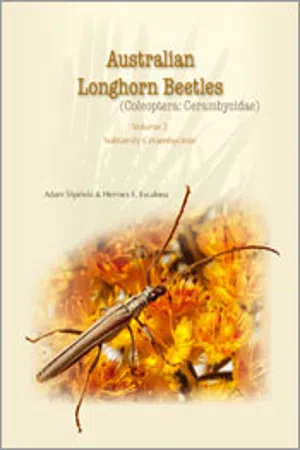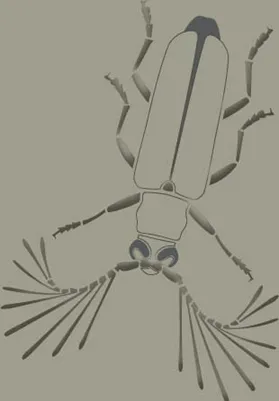![]()
Review of the Australian genera of Cerambycinae
![]()
Acrogenius Blackburn
(Figure 39C,D)
Acrogenius Blackburn, 1896a: 38. Type species by monotypy, Acrogenius tinctus Blackburn, 1896a.
Acrogenoides McKeown, 1945: 291, unnecessary replacement for Acrogenius Blackburn, 1896a.
Tribe: Tillomorphini
References: Aurivillius 1912: 422; McKeown 1947: 102.
Diagnosis
Small to medium-sized, distinctive beetles (Fig. 39C) with dorsum yellow, black and orange and antennae filiform, extending slightly behind abdominal apex. Frontoclypeus transverse. Gland opening at base of mandibles absent. Eyes finely facetted, distinctly emarginate. Antennal tubercles broadly separated. Antennal foramen depressed; anterior margin close to mandibular articulation. Antennal scape distinctly shorter than pronotum; pedicel as long as wide; antennomere 3 almost twice length of scape; antennomeres 3–7 with apical spines. Pronotum subquadrate, lateral margins arcuate, smooth; pronotal disc indistinctly tuberculate. Prosternal process moderately broad, weakly expanded apically, flat. Procoxal cavities rounded with narrow lateral extensions; open externally. Procoxae weakly projecting below prosternal process. Mesoventrite flat in front of mesocoxae; mesoventral intercoxal process as broad as coxa, without secondary articulation, emarginate apically. Mesocoxal cavities broadly open to mesepimeron; mesotrochantin exposed. Elytra without costae, with ivory-coloured markings; punctures distinct, not in rows; apices externally spinose. Femora strongly thickening toward apices; metafemur exceeding apex of abdomen; tibiae not flattened.
Description
LENGTH 10–12 mm. Body elongate-oval, length 3.2–3.5 times width. Dorsal surfaces with contrasting yellow, black and orange colours, bearing both short recumbent and elongate erect setae. Sexual dimorphism: unknown.
HEAD capsule as long as wide, not constricted behind eyes. Frontoclypeus slightly inclined, transverse. Frontoclypeal suture weakly impressed. Longitudinal groove in front of eye absent. Gland opening at base of mandibles absent. Median frontal groove complete anteriorly. Eyes finely facetted, distinctly emarginate, lobes joined by 3–4 rows of ommatidia; frontal interocular index 3.0–3.5; upper lobes separated dorsally by 2.0–2.5 times diameter of antennal socket; lower lobes not extended ventrally. Gena in front of eye relatively long. Labrum transverse. Ligula membranous. Apical labial palpomere distinctly widened apically, longer than penultimate palpomere. Apical maxillary palpomere strongly widened apically, longer than penultimate palpomere. Antennal insertions wide apart, separated by 3.0–3.5 times diameter of antennal foramen. Antennal foramen depressed; anterior margin relatively close to mandibular articulation; dorsal-most margin approximately level with uppermost level of eye.
ANTENNAE. Antenna 11-segmented, filiform; slightly exceeding apex of elytra. Antennomeres bearing sparse ventral fringe of long setae. Scape gradually expanded toward apex, 0.3–0.4 pronotum length, posteriorly extends to anterior margin of pronotum, rounded apically. Pedicel subquadrate. Antennomere 3 with short apical spine, 1.8–2.0 times as long as scape; antennomeres 4–6 with very short apical spines or prominent inner apical angles; terminal segment as long as penultimate.
PROTHORAX. Pronotum as long as wide; wider than head; widest near middle; not constricted at apex, weakly constricted at base. Pronotal disc indistinctly tuberculate and punctate; lateral margins arcuate, without projections. Prosternum in front of procoxae 2.5–3.0 times mid length of procoxal cavity. Prosternal process about 0.6 times as wide as coxal cavity, slightly expanded posteriorly; flat. Procoxal cavities circular with very narrow gap laterally; widely open posteriorly. Procoxae convex, slightly projecting below level of prosternum.
PTEROTHORAX. Scutellum apically pointed, sparsely clothed with depressed setae. Mesonotum with striated stridulatory area. Mesoventrite in front of coxae flat. Mesocoxae distinctly separated, at narrowest point separated by at least one cavity diameter; secondary mesocoxal articulation absent; mesoventral intercoxal process deeply notched apically. Mesocoxal cavity narrowly open to mesepimeron; mesotrochantin hardly visible externally. Metaventrite with scent gland openings near postero-lateral angles.
ELYTRA. Length 2.5–2.7 times mid length of prothorax; covering entire abdomen; straight and interlocking along suture; lateral edge of elytron straight or weakly sinuate; raised ridges or costae absent; elytral punctures distinct, irregular; vestiture of elytra comprising both short recumbent and elongate erect setae; surface with longitudinal and transverse raised ivory-coloured markings; elytral apices truncate weakly spinose on external angles.
LEGS. Protrochanter strongly oblique. Protibial spurs paired. Meso- and metafemora pedunculate-clavate (abruptly thickening distally). Metafemur exceeding apex of abdomen. Tibiae not carinate. Metatarsomere 1 shorter than tarsomeres 2–5 together, as long as hind tarsomeres 2 and 3 together. Pretarsal claws widely divergent.
ABDOMEN. Abdominal ventrites without patches of dense white setae. Ventrite 1 as long as 2 with well-delimited coxal cavities; intercoxal process triangular and pointed apically. Ventrite 5 in male about as long as 4, truncate or broadly rounded apically. Female ventrite 5 distinctly tapered toward apex, rounded.
MALE TERMINALIA. Not examined
Remarks
The orange pronotum, complex, elevated ivory markings on black elytra, strongly clavate femora and short spines on antennomeres 3–5 easily distinguish Acrogenius from other Australian genera of Cerambycinae.
Biological data
Biology and host plants unknown; one specimen was collected in December 1933.
Distribution
In addition to the holotype of A. tinctus, only three specimens from historic collections have been available for study. Acrogenius is endemic to northern Queensland extending from Cape York south to Millmerran near Toowoomba.
Australian species
tinctus Blackburn
Acrogenius tinctus Blackburn, 1896a: 38.
TL: North Queensland (syntype examined, MV; Fig. 271C).
Adrium Pascoe
(Figure 35D,E)
Adrium Pascoe, 1866b: 105. Type species by original designation, Callidium catoxanthum White, 1855.
Tribe: Callidiopini
References: Aurivillius 1912: 119; McKeown 1947: 46; Matthews 1997: 10.
Diagnosis
Small, dorsally flattened, mostly brown to black beetles with short antennae usually extending beyond posterior margin of pronotum (Fig. 35D). Frontoclypeus transverse. Gland opening at base of mandibles absent. Eyes large, coarsely facetted, deeply emarginate. Antennal tubercles broadly separated. Antennal foramen depressed; anterior margin close to mandibular articulation. Antennal scape slender, distinctly shorter than pronotum; pedicel as long as wide; antennomere 3 shorter than scape without apical spine. Pronotum transverse, lateral margins arcuate; pronotal disc with low tubercles or shiny nodules. Prosternal process narrow, weakly expanded apically. Procoxal cavities circular without lateral extensions; open externally. Procoxae not extending below prosternal process. Mesoventrite flat anteriorly. Mesocoxal cavities broadly separated medially, closed to mesepimeron; mesotrochantin not visible. Elytra without ridges, punctures at base large, irregular. Femora and tibiae not flattened.
Description
LENGTH 5.0–12 mm. Body elongate-oval, length 3.8–4.1 times width. Do...

